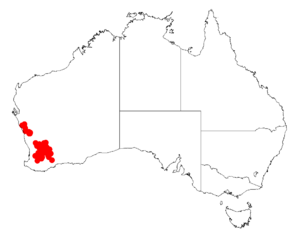Acacia tratmaniana facts for kids
Quick facts for kids Acacia tratmaniana |
|
|---|---|
| Scientific classification | |
| Genus: |
Acacia
|
| Species: |
tratmaniana
|
 |
|
| Occurrence data from AVH | |
Acacia tratmaniana is a type of shrub. It belongs to the Acacia family, which is a large group of plants. This shrub is special because it only grows naturally in southwestern Australia. When a plant or animal only lives in one specific area, we call it endemic.
What Does It Look Like?
This Acacia shrub is usually bushy and stands straight up. It can grow to be about 1.5 to 3 meters (5 to 10 feet) tall. Its small branches are covered in fine, silky hairs and have sticky, raised lines.
- Instead of regular leaves, Acacia tratmaniana has special structures called phyllodes. These phyllodes are like flattened leaf stems that do the job of leaves.
- The phyllodes grow upwards or spread out. They are slightly curved and have four sides, like a square or rectangle, when you look at them in a cross-section.
- These phyllodes are thin and smooth, without any hairs. They can be from 2.5 to 11 centimeters long and only 0.5 to 0.7 millimeters wide. Each corner of the four-sided phyllode has a clear vein.
- This plant produces bright yellow flowers. It blooms during the winter months, from July to September.
Where Does It Grow?
Acacia tratmaniana is found in the Wheatbelt region of Western Australia. It often grows in places like rocky ridges, flat areas, and even salt flats.
- You can find it growing in sandy soils or sandy loam soils. These soils sometimes have small pieces of laterite gravel, which is a type of reddish soil.
- Most of these shrubs are found in an area stretching from Wongan Hills and Mukinbudin in the north. The population extends south to places like Pingelly and Hyden.
- There are also some smaller groups of these plants that are separated from the main population. These are found around Geraldton.

All content from Kiddle encyclopedia articles (including the article images and facts) can be freely used under Attribution-ShareAlike license, unless stated otherwise. Cite this article:
Acacia tratmaniana Facts for Kids. Kiddle Encyclopedia.
